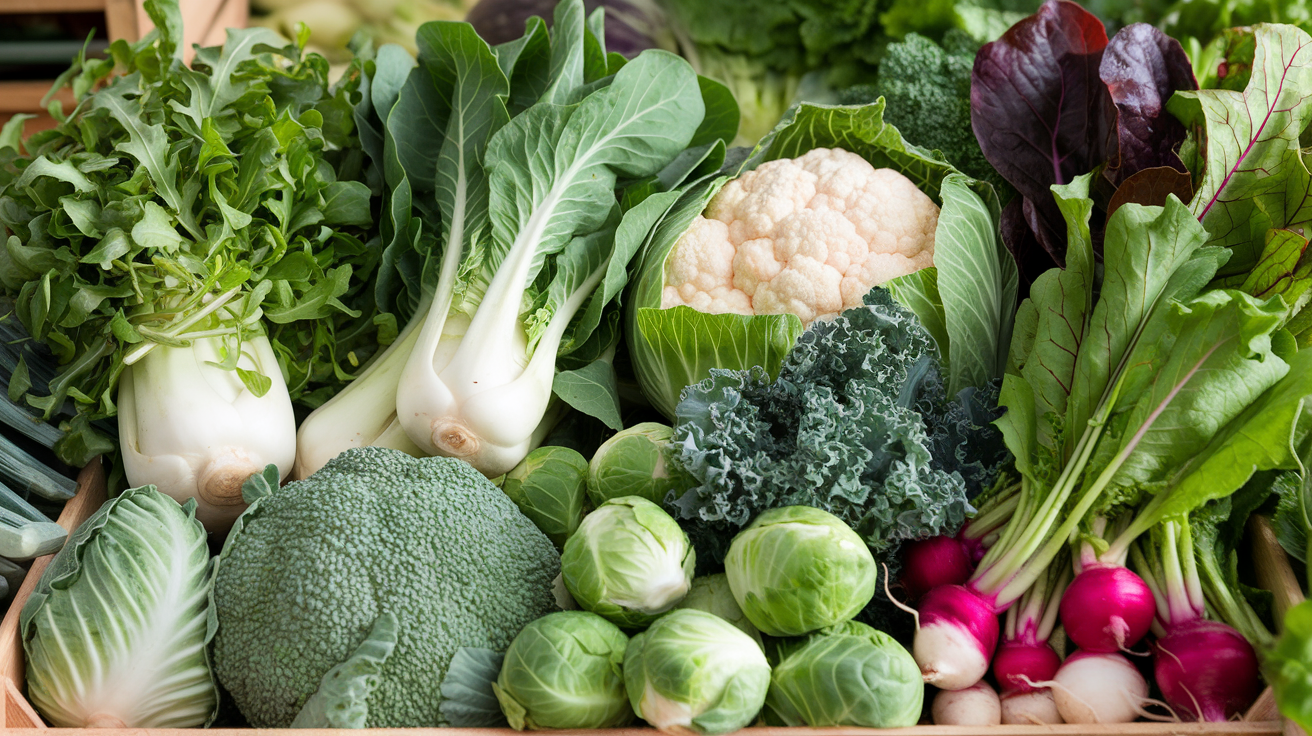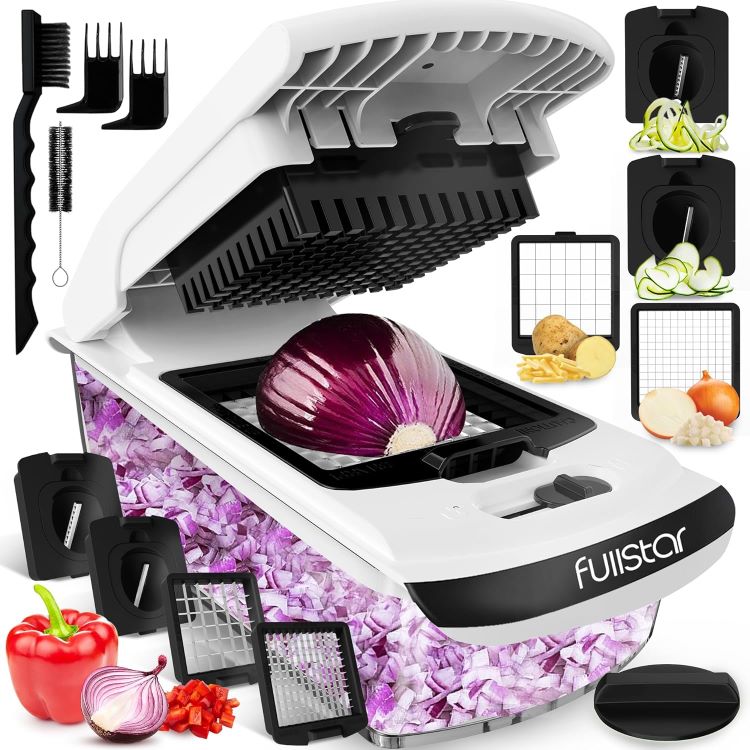Cruciferous vegetables are a group of nutrient-packed foods that offer many health benefits. These veggies include broccoli, cauliflower, kale, and Brussels sprouts.
They're part of the Brassicaceae family and are known for their distinct, sometimes strong flavors.
Amazon Affiliate Disclaimer
We participate in the Amazon Services LLC Associates Program, an affiliate marketing program that allows us to earn fees by linking to Amazon.com and its affiliated sites. If you click on an Amazon affiliate link on our site and make a purchase, we may receive a small commission at no additional cost to you.

Eating cruciferous vegetables can boost your health by providing essential nutrients, fiber, and unique plant compounds called phytochemicals.
These foods are low in calories but high in vitamins, minerals, and antioxidants. They're especially rich in vitamin C, vitamin K, and folate.
The fiber in cruciferous veggies supports digestive health and can help with weight management.
Phytochemicals in these foods may help reduce the risk of certain diseases, including some types of cancer.
Adding more cruciferous vegetables to your diet is a simple way to improve your nutrition and overall health.
Nutritional Composition
Cruciferous vegetables pack a powerful nutritional punch. They contain essential vitamins, minerals, fiber, and unique plant compounds that offer numerous health benefits.
Vitamins and Minerals
Cruciferous veggies are rich in vitamins and minerals. Vitamin C is abundant in these foods, boosting immune function and skin health.
Folate, crucial for DNA synthesis and cell division, is found in high amounts. Vitamin K, important for blood clotting and bone health, is also present in significant quantities.
These vegetables contain essential minerals like:
- Potassium
- Magnesium
- Calcium
- Iron
- Phosphorus
- Zinc
- Selenium
Kale, for example, is an excellent source of calcium, containing 22-150 mg per 100 grams.
Fiber Content
Cruciferous vegetables are known for their high fiber content. Fiber aids digestion promotes feelings of fullness and supports gut health.
A typical serving of cruciferous veggies provides a significant portion of the daily recommended fiber intake.
This fiber helps:
- Regulate blood sugar levels
- Lower cholesterol
- Prevent constipation
- Feed beneficial gut bacteria
The combination of low calories and high fiber makes these vegetables ideal for weight management and overall digestive health.
Phytonutrients and Antioxidants
Cruciferous vegetables contain unique phytonutrients called glucosinolates. When broken down, these compounds form indoles and isothiocyanates, which have potential anti-cancer properties.
Sulforaphane, a powerful antioxidant, is formed from glucosinolates in cruciferous veggies. It may help reduce inflammation and oxidative stress in the body.
These vegetables are also rich in carotenoids, including beta-carotene, lutein, and zeaxanthin. These compounds support eye health and act as antioxidants.
The combination of various antioxidants in cruciferous vegetables helps protect cells from damage and may lower the risk of chronic diseases.
Health Benefits
Cruciferous vegetables offer many health benefits. They support digestive health, may help prevent cancer, aid in weight management, and reduce inflammation in the body.
Digestive Health
Cruciferous veggies are high in fiber, which is great for digestion. Fiber helps food move through the gut smoothly.
It also feeds good gut bacteria. This can improve overall digestive health.
Eating these vegetables regularly may reduce the risk of digestive issues. They can help prevent constipation and keep bowel movements regular.
Some people may experience gas when eating cruciferous veggies. Starting with small amounts and slowly increasing intake can help reduce this effect.
Cancer Prevention
Cruciferous vegetables contain compounds that may help prevent cancer. These compounds are called glucosinolates.
When the vegetables are chopped or chewed, glucosinolates break down into active compounds. These include indoles and isothiocyanates.
Studies show these compounds may:
- Stop cancer cells from growing
- Kill cancer cells
- Prevent tumors from forming new blood vessels
Research suggests eating cruciferous veggies may lower the risk of several types of cancer. These include lung, colorectal, breast, and prostate cancers.
Weight Management
Cruciferous vegetables can be helpful for weight management. They are low in calories but high in nutrients.
These veggies range from 5 to 14 calories per ounce. This makes them a great choice for people trying to lose weight or maintain a healthy weight.
The fiber in these vegetables helps people feel full. This can reduce overeating and snacking between meals.
Cruciferous veggies also take longer to eat. This can slow down meals and help with portion control.
Adding these vegetables to meals can increase nutrient intake without adding many calories.
Inflammatory Response
Cruciferous vegetables may help reduce inflammation in the body. They contain antioxidants and other anti-inflammatory compounds.
Chronic inflammation is linked to many health problems. These include heart disease, diabetes, and certain cancers.
Vitamins C, E, and K in these vegetables act as antioxidants. They help protect cells from damage that can lead to inflammation.
Eating cruciferous veggies regularly may help lower markers of inflammation in the body. This can support overall health and reduce the risk of chronic diseases.
Types of Cruciferous Vegetables
Cruciferous vegetables come in many shapes, sizes, and flavors. They offer a variety of nutritional benefits and can be prepared in numerous ways.
Common Varieties
Broccoli and cauliflower are two of the most popular cruciferous vegetables. Broccoli has dark green florets and a thick stalk, while cauliflower has white florets. Both are versatile and can be eaten raw or cooked.
Brussels sprouts look like tiny cabbages and have a slightly bitter taste. They're often roasted or sautéed.
Cabbage comes in several types, including green, red, and Napa. It's crunchy when raw and becomes tender when cooked.
Kale is a leafy green with a robust flavor. It's often used in salads or smoothies.
Lesser-Known Varieties
Bok choy is a type of Chinese cabbage with white stalks and dark green leaves. It has a mild flavor and is commonly used in stir-fries.
Arugula, also known as rocket, has peppery leaves often used in salads or as a pizza topping.
Collard greens have large, tough leaves that become tender when cooked. They're a staple in Southern U.S. cuisine.
Radishes are small, crunchy root vegetables with a spicy flavor. They're usually eaten raw in salads.
Turnips have edible roots and greens. The roots are often roasted or mashed, while the greens can be sautéed.
Culinary Uses

Cruciferous vegetables offer diverse options in the kitchen. They can be enjoyed raw, cooked, or blended into various dishes. Their unique flavors and textures make them versatile ingredients in many cuisines.
Salads and Raw Preparations
Cruciferous vegetables shine in salads and raw preparations. Broccoli florets, cauliflower florets, and shredded cabbage add crunch and vibrance to salads. Arugula provides a peppery kick as a salad base.
For a quick slaw, mix shredded cabbage with carrots and a tangy dressing. Brussels sprouts can be thinly sliced and tossed with lemon juice, olive oil, and Parmesan cheese for a simple side dish.
Raw cruciferous veggies make great dippers for hummus or ranch dressing. They can also be added to smoothies for a nutrient boost.

Cooking Techniques
Cruciferous vegetables respond well to various cooking methods. Roasting brings out their natural sweetness.
Toss broccoli or cauliflower with olive oil, garlic, and salt, then roast at 400°F for 20-25 minutes.
Steaming preserves nutrients and texture. Steam broccoli or Brussels sprouts for 5-7 minutes until tender-crisp.
Stir-frying is quick and flavorful. Heat oil in a wok, add chopped vegetables and cook for 3-5 minutes. Finish with soy sauce or sesame oil.
Sautéing works well for leafy greens like kale or collards. Cook in olive oil with garlic until wilted.
Recipe Ideas
Cruciferous vegetables can be incorporated into many dishes.
For a hearty soup, simmer cauliflower with onions and broth, then blend until smooth. Add roasted broccoli to pasta dishes for extra nutrition and flavor.
Make a stir-fry with mixed cruciferous veggies, tofu, and a ginger-soy sauce. For a simple side, sauté Brussels sprouts with bacon and finish with a balsamic glaze.
Try a kale and quinoa salad with lemon dressing for a nutrient-packed meal. Roast cabbage wedges and serve with a creamy garlic sauce for an unexpected treat.
Considerations in a Balanced Diet

Eating cruciferous vegetables offers many health benefits, but there are some important factors to keep in mind. These include how much to eat daily, possible allergic reactions, and interactions with certain medications.
Daily Consumption
Cruciferous vegetables are packed with nutrients. Experts suggest eating 1-2 cups per day.
This amount provides fiber, vitamins, and minerals without overdoing it.
Cruciferous veggies are low in calories, ranging from 5-14 calories per ounce. They help reduce obesity when part of a healthy diet.
There are many ways to add these vegetables to meals:
- Raw in salads
- Steamed as a side dish
- Roasted with olive oil
- Added to soups and stews
Variety is key. Try different types like broccoli, cauliflower, kale, and Brussels sprouts to get a range of nutrients.
Potential Allergic Reactions
While rare, some people may be allergic to cruciferous vegetables.
Signs of an allergic reaction can include:
- Itching or tingling in the mouth
- Hives or skin rash
- Swelling of lips, tongue, or throat
- Difficulty breathing
These symptoms usually appear within minutes to hours after eating.
If someone suspects an allergy, they should stop eating the food and see a doctor.
Some people may experience bloating or gas when eating these vegetables.
This is normal and often goes away as the body adjusts.
Starting with small amounts and gradually increasing can help.
Interactions with Medications
Cruciferous vegetables can interact with some medications.
These veggies may affect the liver's ability to process drugs. They can change how quickly the body breaks down medications.
People taking blood-thinning drugs like warfarin should be careful.
Cruciferous vegetables are high in vitamin K, which can affect blood clotting.
It's best to eat a consistent amount of these vegetables each week when on blood thinners. This helps keep vitamin K levels steady.
Anyone taking medications should talk to their doctor about possible interactions with cruciferous vegetables.


